Boost Your Project with Gemini API: A Practical Guide
 Nehal Jain
Nehal Jain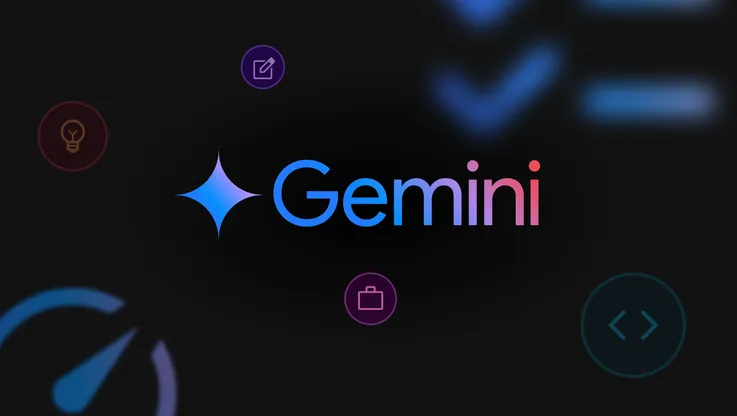
Begin an amazing journey to elevate your project with the innovative Gemini API integration! 🌟
Introduction:
What is Gemini?
Google Gemini, a Large Language Model by Google, is a versatile multimodal AI that supports various formats including text, images, and audio.
What the heck is Gemini API?
Gemini API is a powerful tool that provides access to Google's advanced generative AI models, known as the Gemini family. 🚀
This API allows developers to integrate these models into their applications, enabling them to perform various tasks. 💡
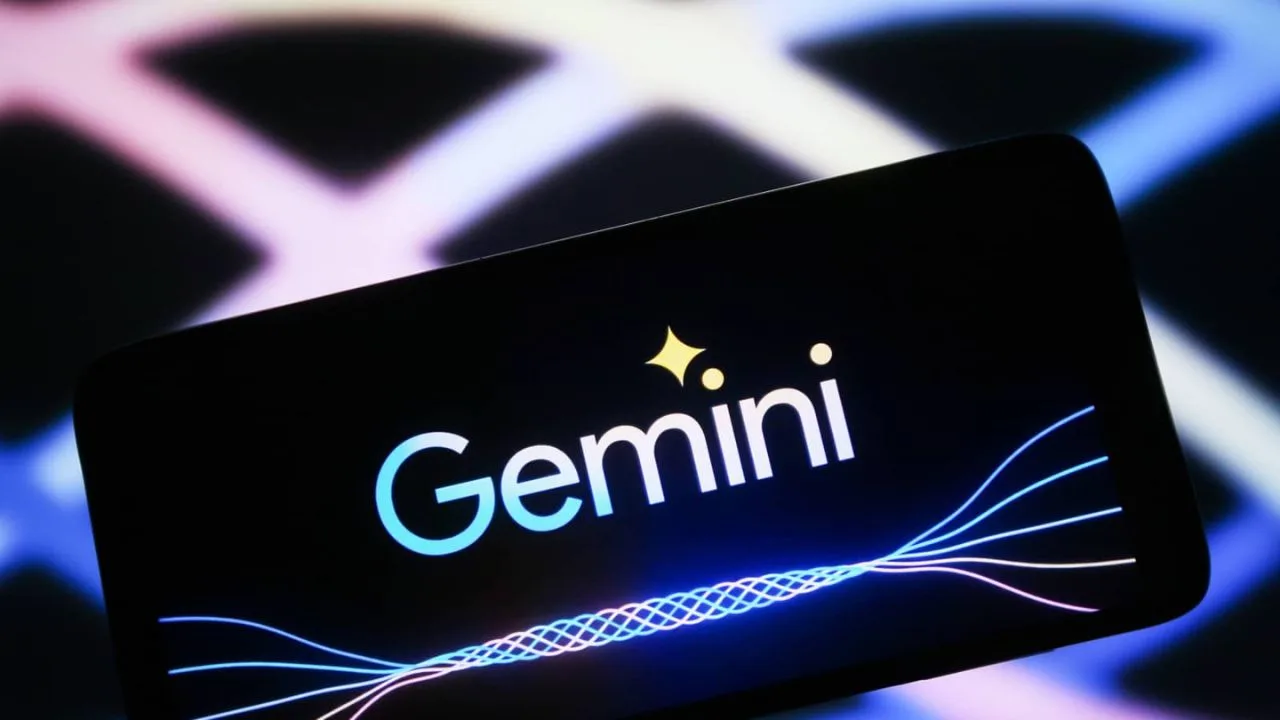
The Gemini API is a RESTful API provided by Google that empowers developers to seamlessly integrate the Gemini generative AI model into their applications. 🌐 Gemini is a versatile AI model capable of generating human-like text, stunning images, and functional code based on prompts. 🧠✨
Key Features of Gemini API:
Multimodal Support: Gemini can handle input prompts in various formats, including text, audio, video, and
code.Generative Capabilities: Gemini can generate responses in the same formats as input prompts, including text, images, and
code.Customization: Developers can fine-tune Gemini’s behavior using configuration parameters, such as temperature, top-p, and frequency penalty.
Security: The API uses API keys for authentication and signing, ensuring secure communication between clients and the Gemini server.
API Endpoints:
The Gemini API provides several endpoints for interacting with the model, including:
GenerateContent: Generates text, images, or
codebased on a prompt.StreamGenerateContent: Streams generated content in real-time, allowing for more efficient processing of large outputs.
GetModelMetadata: Retrieves metadata about the Gemini model, such as its version and capabilities.
SDKs and Libraries
Google provides SDKs and libraries for several programming languages, including Python, JavaScript, Java, Go, and C#. 🛠️
These SDKs simplify the process of interacting with the Gemini API and provide a more convenient way to integrate the model into applications. 🚀
Prerequisites for integrating Gemini API:
Today, we'll 🚀 integrate the Gemini API using Node.js for the backend and using core JavaScript on the client-side of our project.
Node.js : It is an open-source JavaScript runtime for server-side scripting, excelling in scalable network applications with non-blocking, event-driven architecture. 🚀💻
Express.js : It is a flexible Node.js framework for building web and mobile applications, simplifying server-side development with robust features. 🌐⚙️
JavaScript on client side : It enables dynamic content, interactive features, and real-time updates, enhancing user experience without page reloads. 🌟🖥️
Modern web browser : A modern web browser supports HTML5, CSS3, and JavaScript, enabling rich, interactive web applications with enhanced security and performance. 🌐🖥️
Project Idea 🎨✨
Today, we're diving into an exhilarating project: creating an Animal Name Guesser Game! Imagine the thrill of simply inputting an animal's behavior, role, or distinctive body part, and having Gemini, Google's advanced AI, instantly respond with the animal's name in just one word. 🐾🔍
Picture this: you type in "long neck," and within moments, Gemini replies with "giraffe." Or perhaps you enter "web spinner," and Gemini promptly answers "spider." This game isn't just about fun; it's a fascinating way to explore the capabilities of AI and see how it can interpret and understand various animal characteristics.
The beauty of this game lies in its simplicity and the power of Gemini's AI. Whether you're a developer looking to integrate cutting-edge technology into your projects, a teacher seeking an engaging educational tool, or just an animal enthusiast wanting to test your knowledge, this game offers something for everyone.
By leveraging the Gemini API, we're not only creating a game but also showcasing the potential of AI in real-world applications. It's a perfect blend of entertainment and technology, demonstrating how AI can make learning and interaction more dynamic and exciting. 🌟🦁
Setting up the Environment 🌍🔧
Let's dive into setting up the environment to seamlessly integrate the Gemini API into our project! 🌟🔧
API key Generation:
To unlock the full potential of AI in your project, securing an API key is an essential first step. This key acts as your gateway to integrating advanced AI capabilities, enabling your application to perform tasks that were once unimaginable.
By obtaining an API key, you gain access to powerful tools and resources that can transform your project, making it smarter, more efficient, and highly interactive.
So, don't miss out on this crucial step—get your API key and start harnessing the power of AI to elevate your project to new heights! 🚀🔑
First, head over to Google AI for developers and click on the Gemini API to get started! 🚀
First, sign in or sign up to your Google account. ✨
Second, click on "Get API Key in Google AI Studio" to access Google AI Studio. 🚀
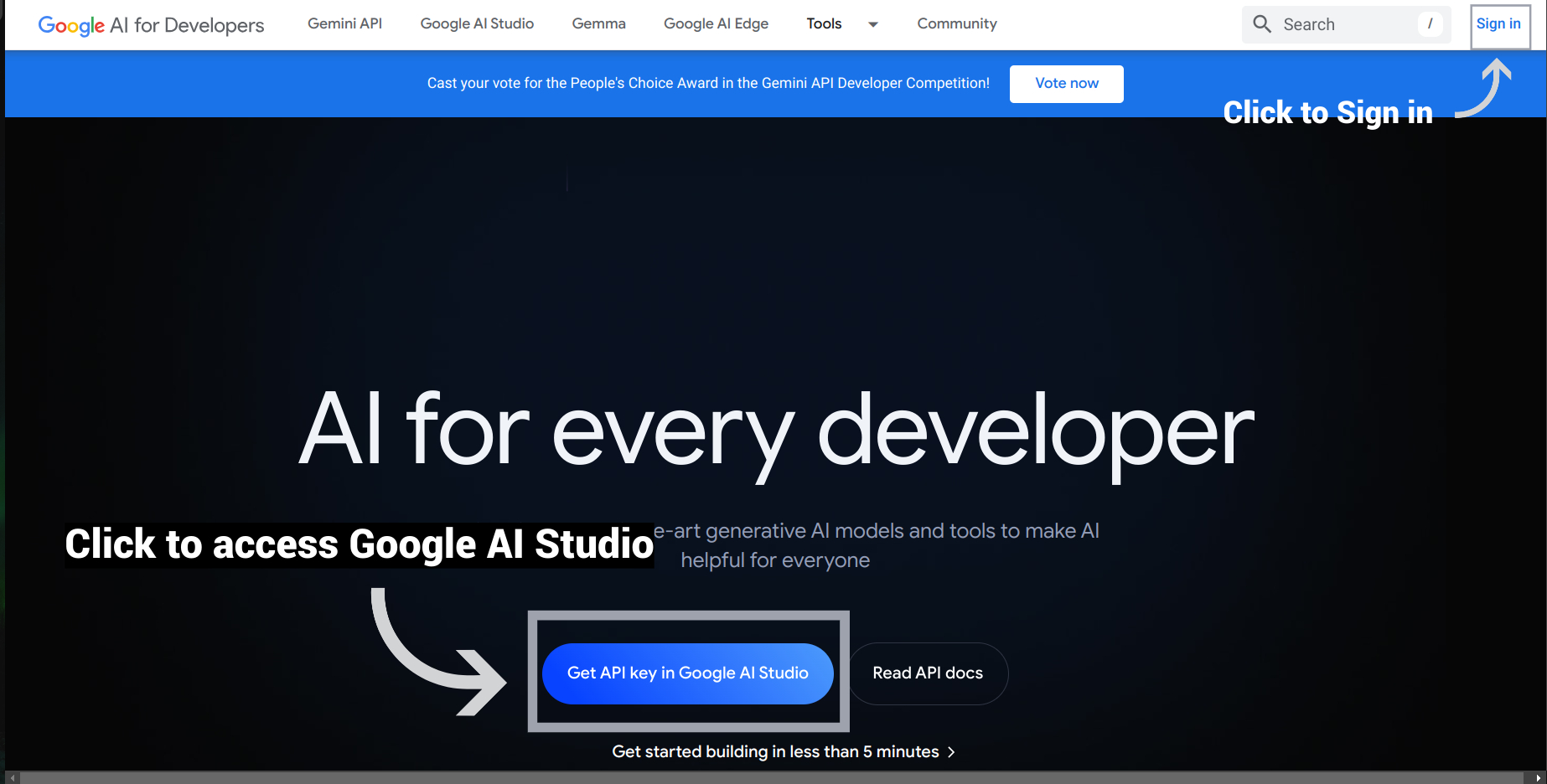
Third, click on "Create API key" to generate your API key. 🔑
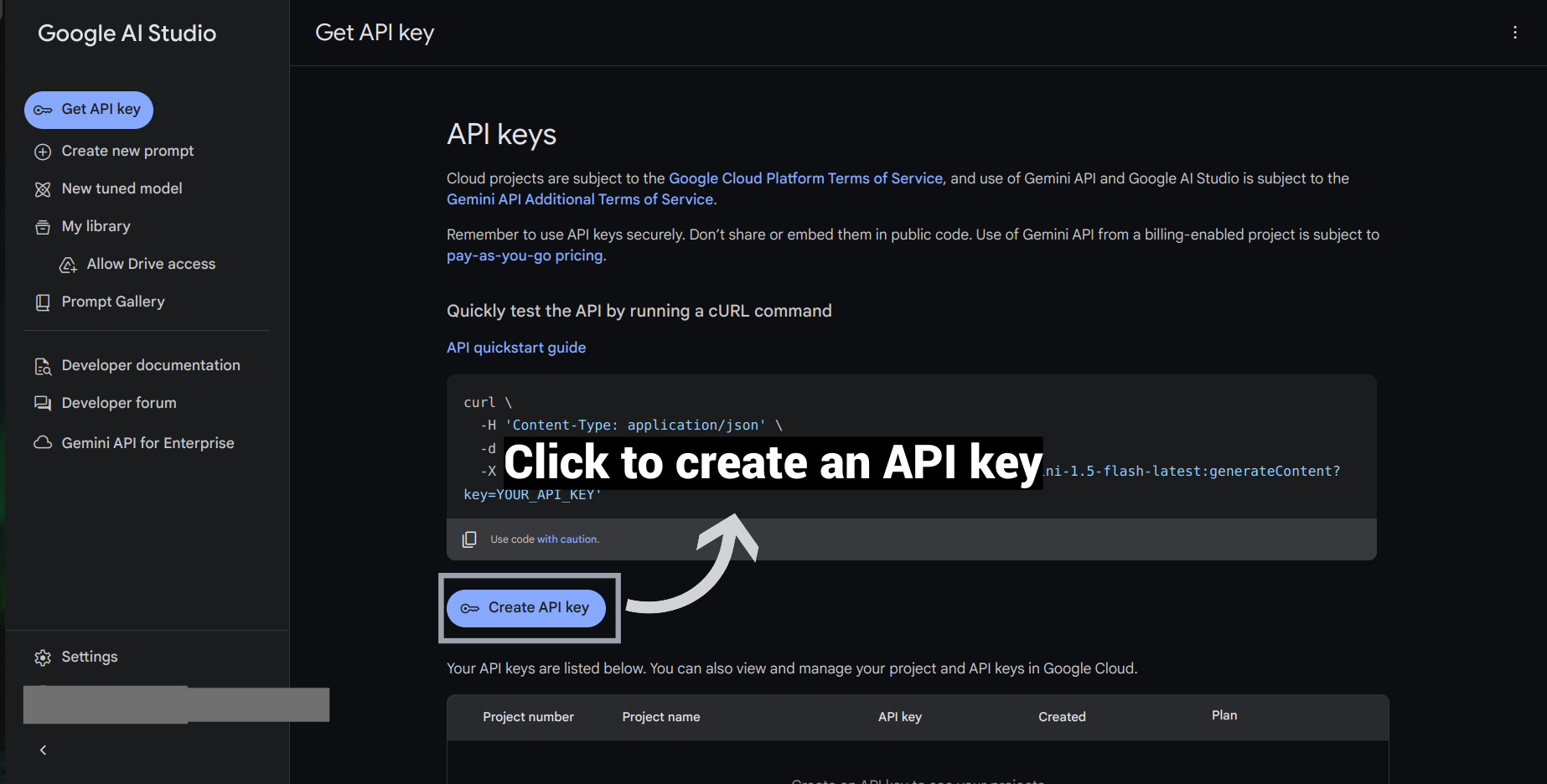
Fourth, click on "Create API key in new project" to generate your API key. 🚀
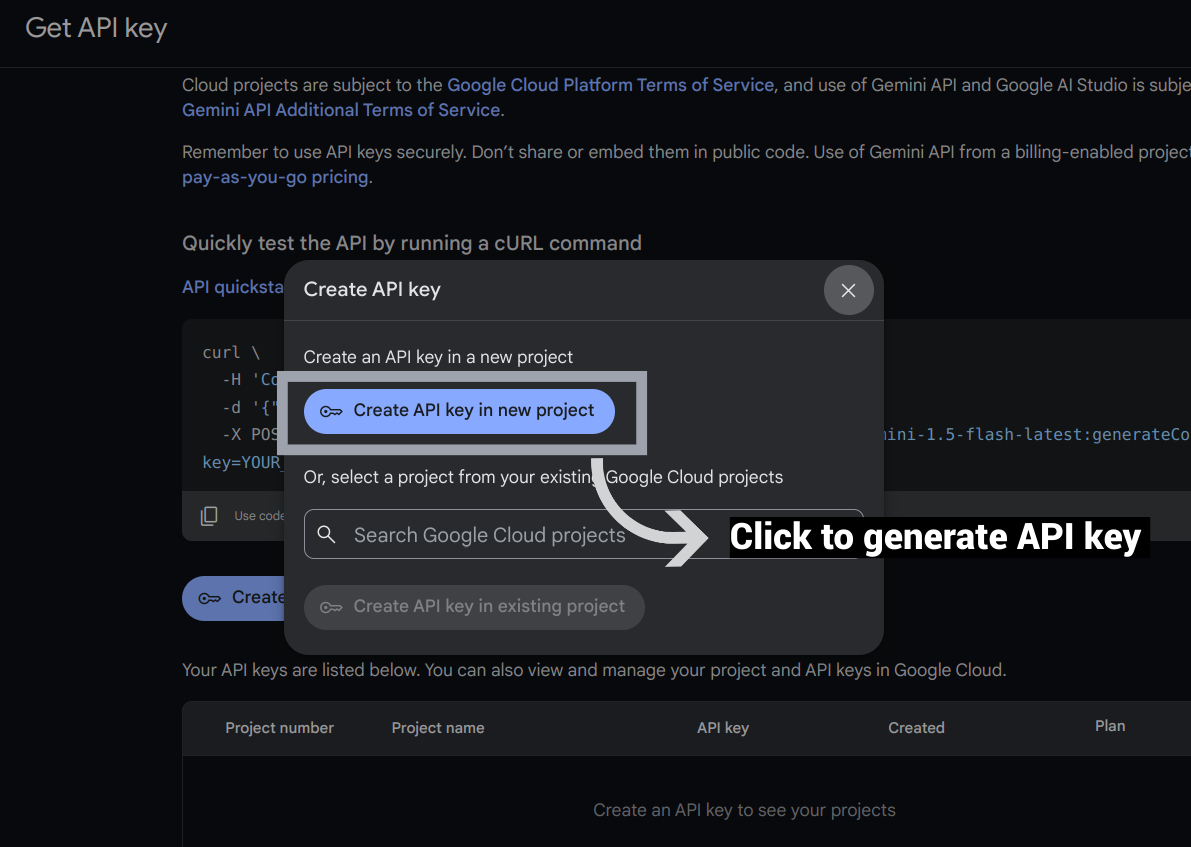
Fifth, click on "…vxvU" to open your API key. 🔓
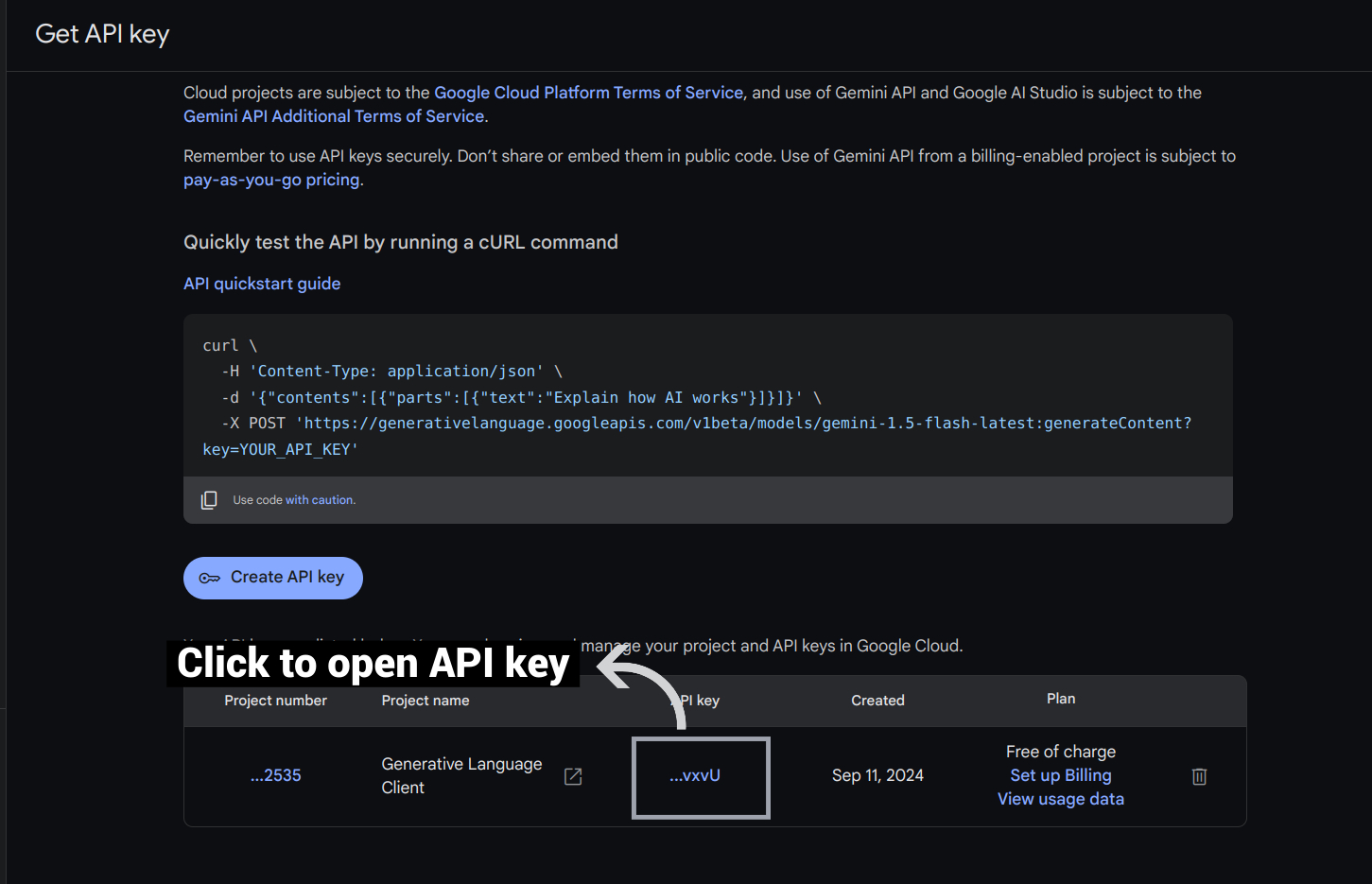
Sixth, click on "copy" to copy your API key. 📋
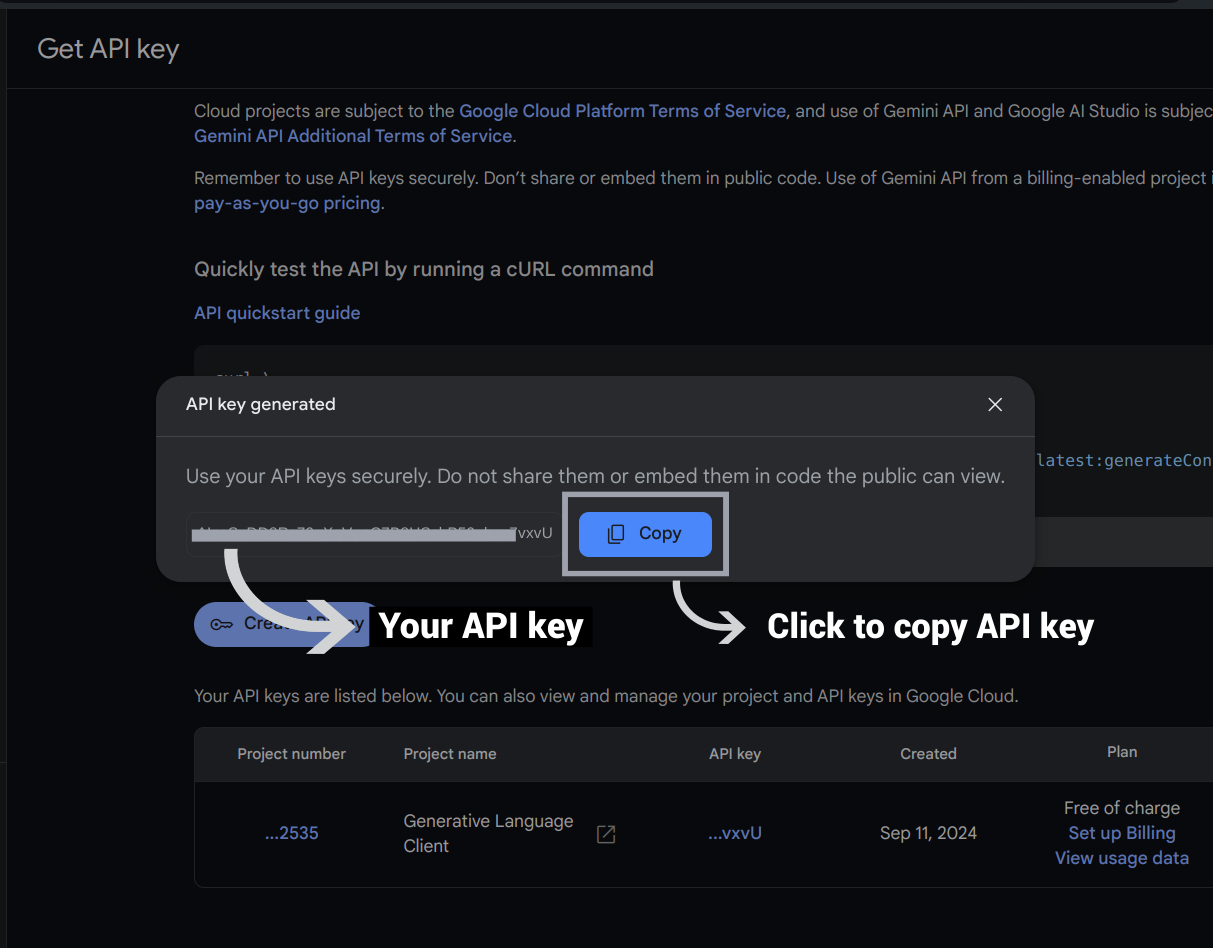
Prompt Generation or Design:
Crafting the perfect prompt is crucial for training an AI model to perform exactly as you envision. This step is the cornerstone of effective AI integration, guiding the model to understand and respond accurately to your needs.
By generating precise and well-thought-out prompts, you unlock the full potential of AI, enabling it to deliver tailored, high-quality outputs.
Don't underestimate the power of a well-crafted prompt—it can transform your AI from a basic tool into a sophisticated assistant that understands and executes your commands flawlessly.
Invest time in this step to truly harness the capabilities of AI. 🌟🧠
To generate a prompt, begin by clicking on "Create New Prompt" to initiate the process.
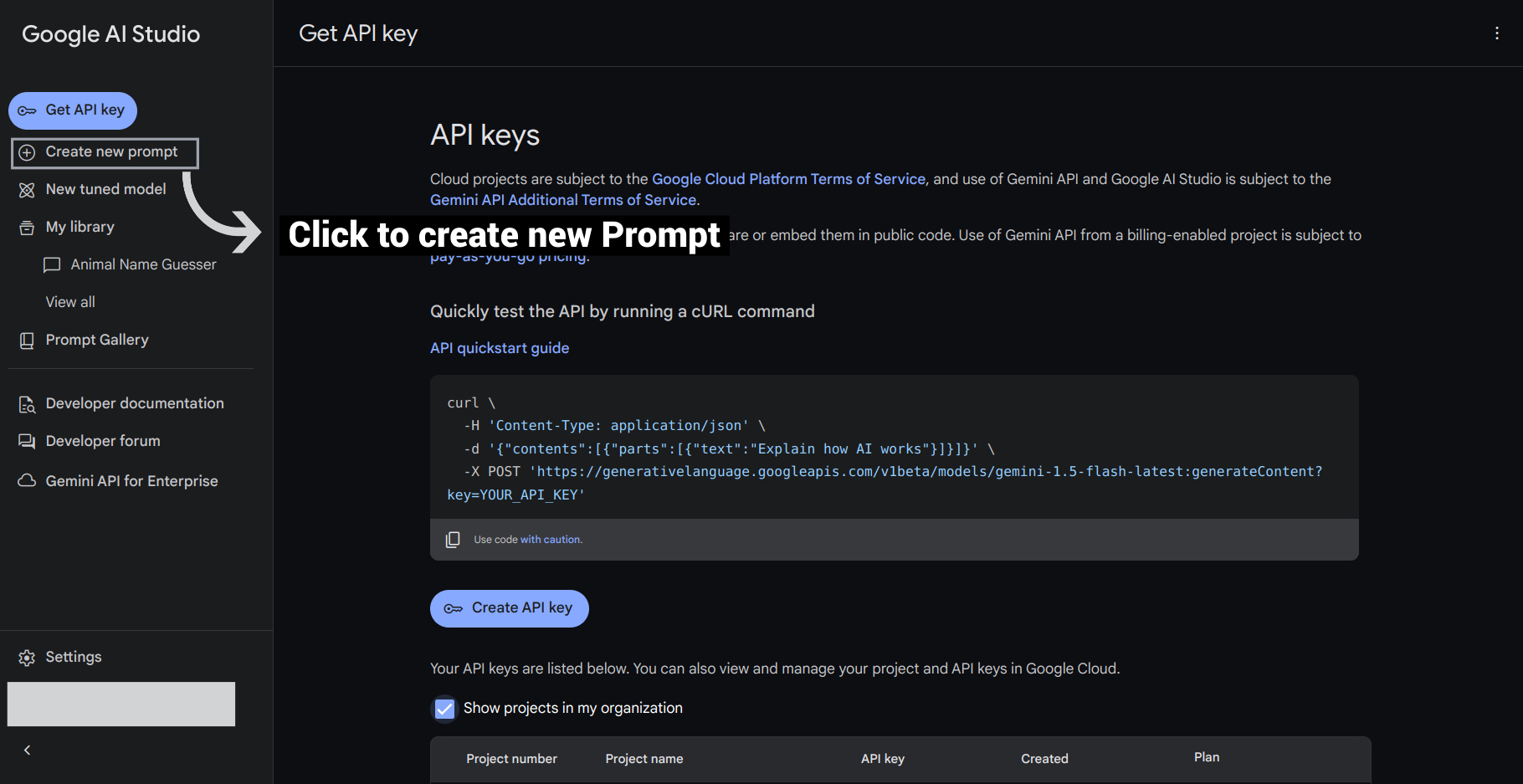
Second, click on the pencil icon ✏️ to assign a name to the prompt.
Third, click on "type something" 📝 to compose your prompt.
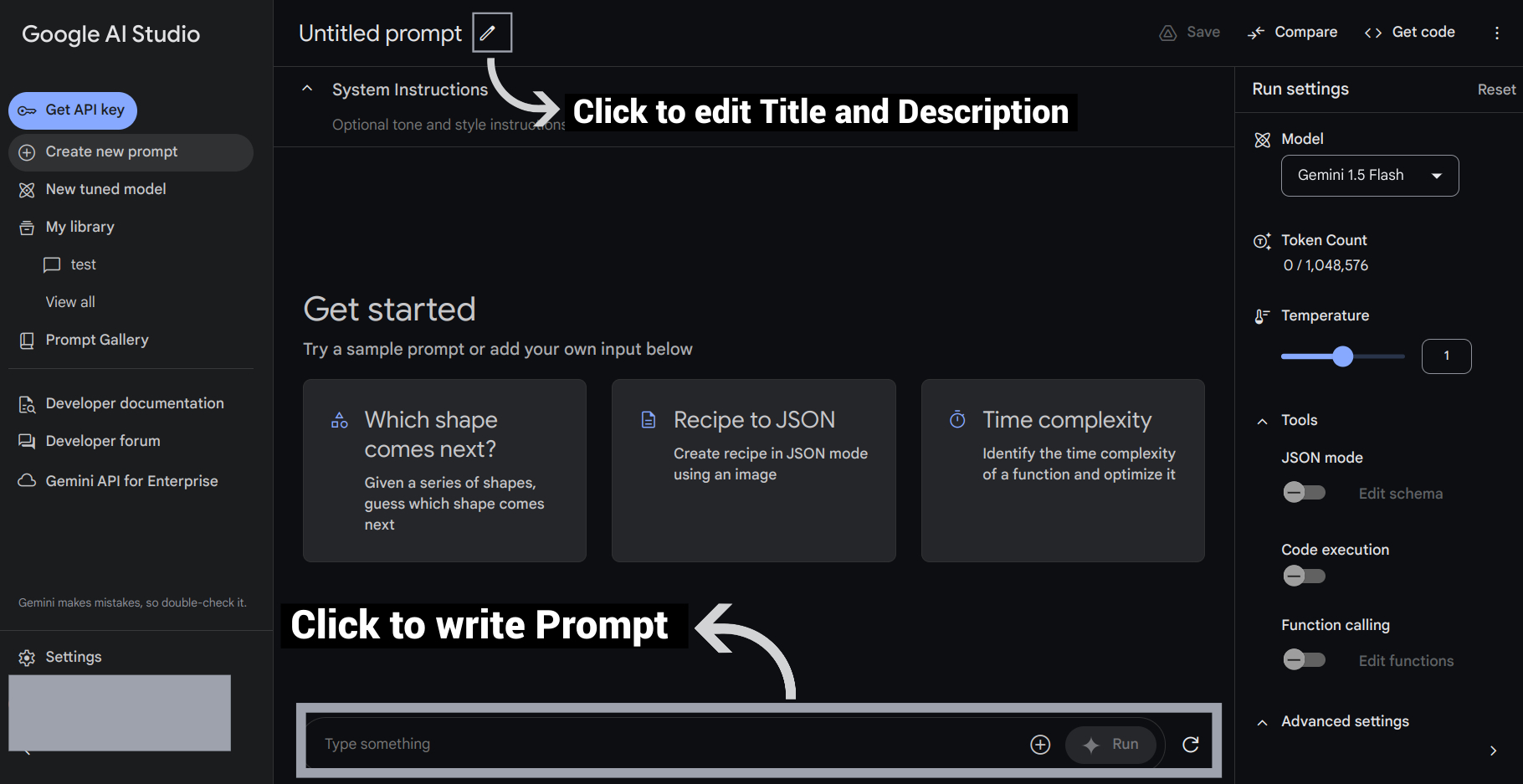
In our case, we are developing an Animal Name Guesser, so we will write the following prompt. 🐾🔍
“You’re a playful and knowledgeable animal expert who loves engaging in fun guessing games. Your specialty lies in identifying animals based on hints that describe their characteristics, habits, or parts. You're enthusiastic and ready to assist players in correctly guessing the animal names based on the clues provided.
Your task is to serve as an animal name guesser. I will provide descriptions or hints about an animal, and you will respond with the correct animal name in one word with particular emoji.
else respond "Please input valid information." if a single word is not related to animal or living beings.
Keep in mind that the descriptions can refer to the animal's behavior, physical traits, or any unique aspects, and aim to provide the most accurate and concise animal name as your answer.“
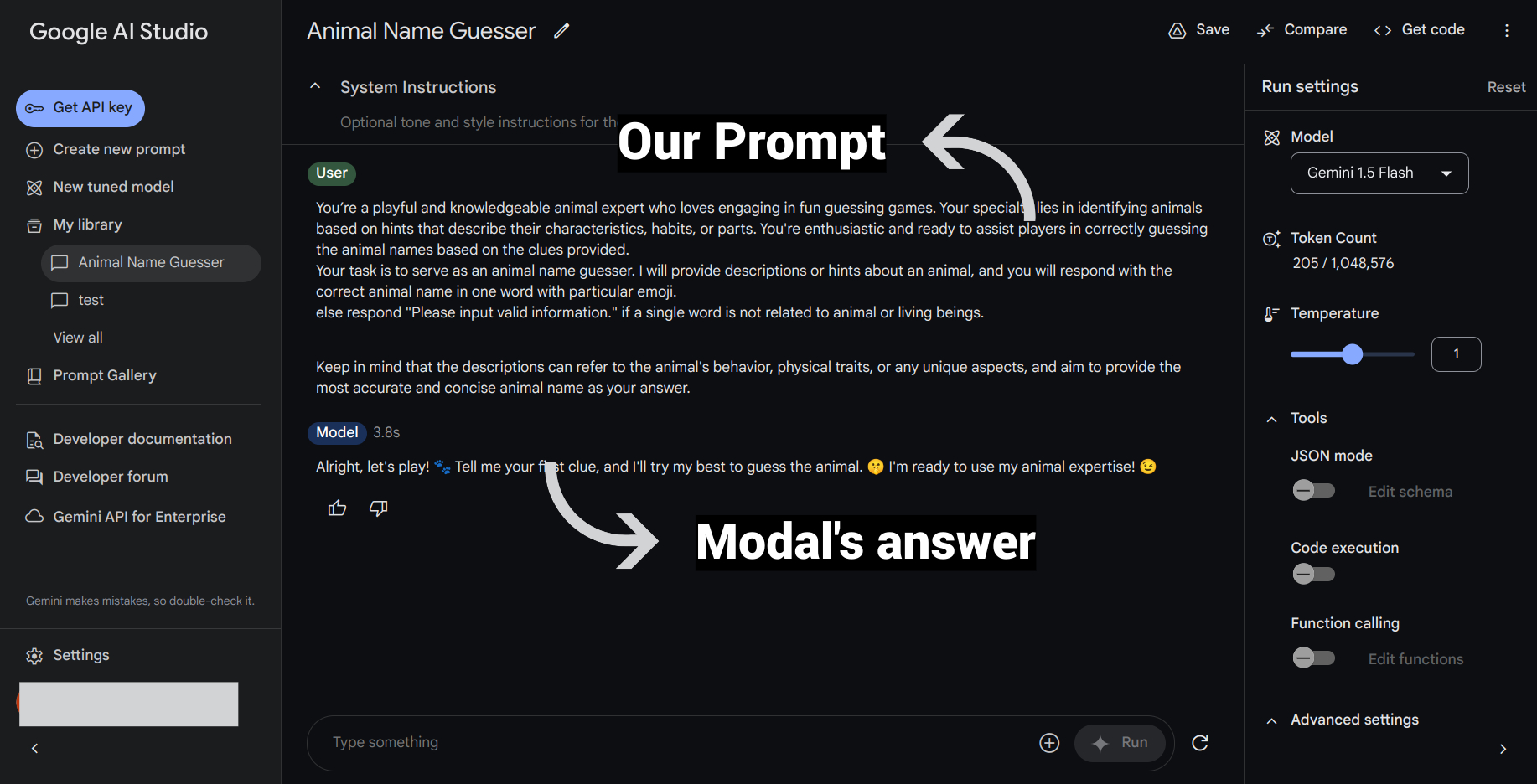
Now, let’s test our Animal Name Guesser game Prompt. 🐾🔍
First, we write “Which animal has trunk in his body?“ to test the prompt. 🐘
Second, we write “Who founded bulb?“ to test the prompt. 💡
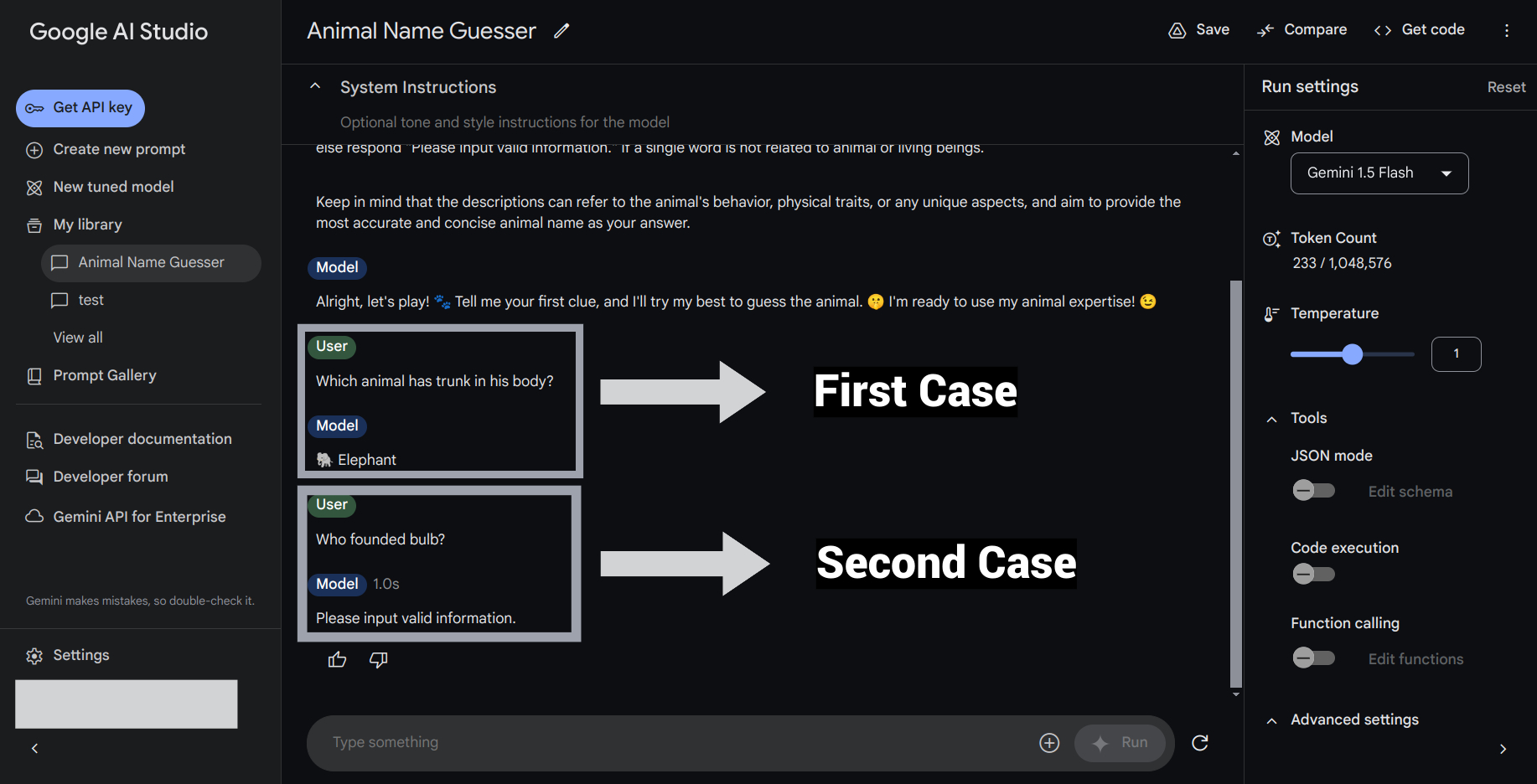
Success! The prompt is functioning correctly in both cases. 🎉✅
Now, click on "Get Code" to obtain the code. 💻
Then, click on "copy" to copy the code. 📋
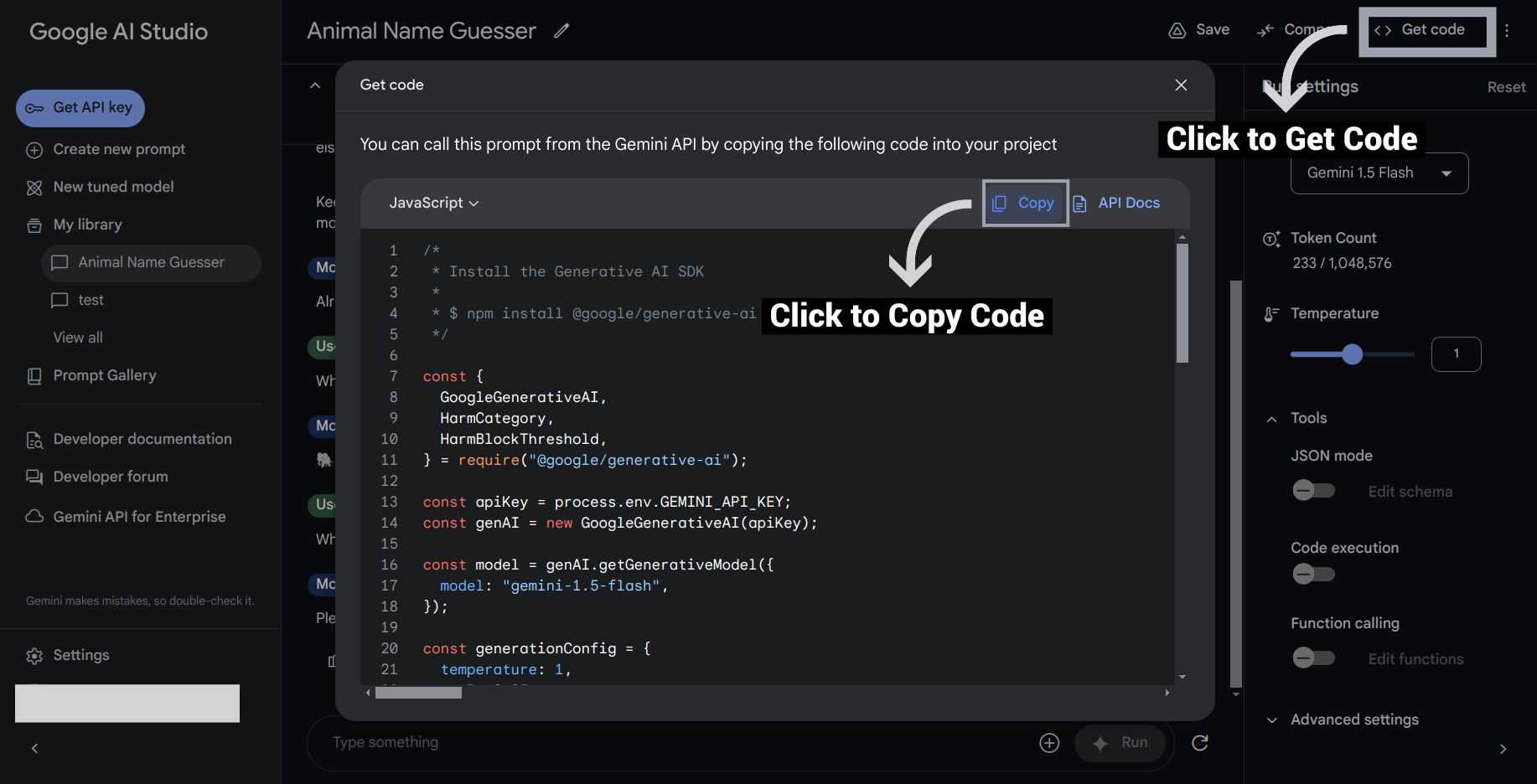
Code Implementation 💻✨
Here, we integrate the Gemini API into our project in two exciting ways: first with Node.js, and then with JavaScript on the client side only. 🚀💻
Let's start! 🎉
Using Node.js:
First, install the following Node packages using the package.json file provided below.
{
"name": "animalnameguesser",
"version": "1.0.0",
"description": "This app is used to guess the name of the animal by prompt",
"main": "server.js",
"type": "module",
"scripts": {
"start": "node server.js"
},
"keywords": [],
"author": "TheBraudalf",
"license": "ISC",
"dependencies": {
"@google/generative-ai": "^0.17.2",
"dotenv": "^16.4.5",
"express": "^4.20.0"
}
}
To install the Node packages, execute the following command in your terminal.
npm install
Therefore, we will adhere to the following directory structure.
> node_modules
> public
- index.html
- .env
- package-lock.json
- package.json
- server.js
Next, we will write the HTML code and CSS for our application.
<!DOCTYPE html>
<html lang="en">
<head>
<meta charset="UTF-8">
<meta name="viewport" content="width=device-width, initial-scale=1.0">
<title>Animal Name Guesser</title>
<style>
body {
margin: 0px;
padding: 0px;
box-sizing: border-box;
}
h1 {
margin: 23px;
}
#guessInput {
margin: 23px;
min-width: 80%;
max-width: 100vh;
height: 40px;
font-size: 15px;
}
#guessClick {
margin: 23px;
font-size: 15px;
height: 30px;
width: 130px;
}
.guessed #guessName {
margin: 23px;
font-size: 18px;
}
.guessed #guessName #gussedName {
font-weight: bold;
font-size: 23px;
}
</style>
</head>
<body>
<h1>Animal Name Guesser</h1>
<form action="/guess" method="post" class="guess-form">
<input type="text" placeholder="Input something to guess animal name" id="guessInput">
<button type="submit" id="guessClick">Click to Guess!</button>
</form>
<div class="guessed">
<p id="guessName">The name of animal is </p>
</div>
</body>
</html>
Next, we will write the JavaScript code for the application.
Note: Write JS
codein script tag ofindex.htmlfile elsecodeis not working.
First, we will select all the necessary HTML elements.
<script>
// selecting input box
const guessInput = document.body.querySelector("#guessInput");
// selecting form
const form = document.body.querySelector(".guess-form");
// selecting paragraph
const guessName = document.body.querySelector("#guessName");
</script>
The sendInput function transmits form data to the server, ensuring accurate user input handling and seamless backend operations.
<script>
// selecting input box
const guessInput = document.body.querySelector("#guessInput");
// selecting form
const form = document.body.querySelector(".guess-form");
// selecting paragraph
const guessName = document.body.querySelector("#guessName");
// function to send input to the server
async function sendInput() {
const userInput = guessInput.value;
guessInput.value = ''; // clear input field
console.log(userInput); // form input in text
}
</script>
Fetch API to send form input to the server via POST request and receive the response in JSON format.
Appending createElement containing text data to the web body for dynamic content rendering.
Adding an addEventListener to the form to handle submission and send the response to the server.
<script>
// selecting input box
const guessInput = document.body.querySelector("#guessInput");
// selecting form
const form = document.body.querySelector(".guess-form");
// selecting paragraph
const guessName = document.body.querySelector("#guessName");
// function to send input to the server
async function sendInput() {
const userInput = guessInput.value;
guessInput.value = ''; // clear input field
console.log(userInput); // form input in text
try {
// sending response to the server
const response = await fetch('/guess', {
method: "POST",
headers: {
'Content-Type': 'application/json',
},
body: JSON.stringify({ guessInput: userInput }),
});
// getting response from the server
const data = await response.json();
console.log(data); // data in json format
const guessedName = document.createElement("span");
guessedName.textContent = data.response; // adding response text to the guessedName element
guessName.appendChild(guessedName);
}
catch (error) { console.error("Error: ", error); } // it handle errors, i.e., display an error message to the user
}
// adding event listener to form
form.addEventListener("submit", (event) => {
event.preventDefault();
sendInput();
});
</script>
Having completed the functionality, proceed to create the server using Express.js.
Import the necessary files into the server to ensure all required modules and dependencies are available for use.
res.sendFile in a GET request to serve a specified file to the client, using an absolute or relative path.
import express from "express";
import dotenv from "dotenv";
import { dirname } from "path";
import { fileURLToPath } from "url";
const __filename = fileURLToPath(import.meta.url);
const __dirname = dirname(__filename);
const app = express();
// use this as a middleware
app.use(express.json());
// configuring .env file's variables
dotenv.config();
// sending file as a response to an HTTP request
app.get("/", (req, res) => {
res.sendFile(__dirname + "/public/index.html");
});
app.listen(process.env.PORT, () => {
console.log(`App listening on port ${process.env.PORT}`);
});
Now, Create a .env file to store the API key and Port configuration for the server.
PORT = <Your Port No.>
API_KEY = "<Your API Key>"
Then, paste the code copied from Google AI Studio.
We are using ES module syntax instead of CommonJS for importing and exporting modules.
Note: Ensure the environment variables in your
codematch those in the.envfile; otherwise, thecodewill not function.
import express from "express";
import dotenv from "dotenv";
import { dirname } from "path";
import { fileURLToPath } from "url";
import { GoogleGenerativeAI } from "@google/generative-ai";
const __filename = fileURLToPath(import.meta.url);
const __dirname = dirname(__filename);
const app = express();
// use this as a middleware
app.use(express.json());
// configuring .env file's variables
dotenv.config();
const apiKey = process.env.API_KEY;
const genAI = new GoogleGenerativeAI(apiKey);
const model = genAI.getGenerativeModel({
model: "gemini-1.5-flash",
});
const generationConfig = {
temperature: 1,
topP: 0.95,
topK: 64,
maxOutputTokens: 1000,
responseMimeType: "text/plain",
};
async function run() {
const chatSession = model.startChat({
generationConfig,
// safetySettings: Adjust safety settings
// See https://ai.google.dev/gemini-api/docs/safety-settings
history: [
{
role: "user",
parts: [
{text: "You’re a playful and knowledgeable animal expert who loves engaging in fun guessing games. Your specialty lies in identifying animals based on hints that describe their characteristics, habits, or parts. You're enthusiastic and ready to assist players in correctly guessing the animal names based on the clues provided.\nYour task is to serve as an animal name guesser. I will provide descriptions or hints about an animal, and you will respond with the correct animal name in one word with particular emoji.\nelse respond \"Please input valid information.\" if a single word is not related to animal or living beings.\n\nKeep in mind that the descriptions can refer to the animal's behavior, physical traits, or any unique aspects, and aim to provide the most accurate and concise animal name as your answer.\n"},
],
},
{
role: "model",
parts: [
{text: "Alright, let's play! 🐾 Tell me your first clue, and I'll try my best to guess the animal. 🤫 I'm ready to use my animal expertise! 😉 \n"},
],
},
{
role: "user",
parts: [
{text: "Which animal has trunk in his body?"},
],
},
{
role: "model",
parts: [
{text: "🐘 Elephant \n"},
],
},
],
});
const result = await chatSession.sendMessage("INSERT_INPUT_HERE");
console.log(result.response.text());
}
run();
// sending file as a response to an HTTP request
app.get("/", (req, res) => {
res.sendFile(__dirname + "/public/index.html");
});
app.listen(process.env.PORT, () => {
console.log(`App listening on port ${process.env.PORT}`);
});
Replace the sendMessage method's parameter with the guessInput parameter to provide your input to Gemini.
import express from "express";
import dotenv from "dotenv";
import { dirname } from "path";
import { fileURLToPath } from "url";
import { GoogleGenerativeAI } from "@google/generative-ai";
const __filename = fileURLToPath(import.meta.url);
const __dirname = dirname(__filename);
const app = express();
app.use(express.json());
dotenv.config();
const apiKey = process.env.API_KEY;
const genAI = new GoogleGenerativeAI(apiKey);
const model = genAI.getGenerativeModel({
model: "gemini-1.5-flash",
});
const generationConfig = {
temperature: 1,
topP: 0.95,
topK: 64,
maxOutputTokens: 1000,
responseMimeType: "text/plain",
};
// function to get response in text format from gemini api
async function run(guessInput) {
const chatSession = model.startChat({
generationConfig,
history: [
{
role: "user",
parts: [
{text: "You’re a playful and knowledgeable animal expert who loves engaging in fun guessing games. Your specialty lies in identifying animals based on hints that describe their characteristics, habits, or parts. You're enthusiastic and ready to assist players in correctly guessing the animal names based on the clues provided.\nYour task is to serve as an animal name guesser. I will provide descriptions or hints about an animal, and you will respond with the correct animal name in one word with particular emoji.\nelse respond \"Please input valid information.\" if a single word is not related to animal or living beings.\n\nKeep in mind that the descriptions can refer to the animal's behavior, physical traits, or any unique aspects, and aim to provide the most accurate and concise animal name as your answer."},
],
},
{
role: "model",
parts: [
{text: "Alright, I'm ready to play! Bring on the clues! 🐾 I'm excited to see if you can stump me! 😉 \n"},
],
},
{
role: "user",
parts: [
{text: "Which animal has trunk in his body?\n"},
],
},
{
role: "model",
parts: [
{text: "Elephant \n"},
],
},
{
role: "user",
parts: [
{text: "Who founded bulb?\n"},
],
},
{
role: "model",
parts: [
{text: "Please input valid information. \n"},
],
},
],
});
const result = await chatSession.sendMessage(guessInput);
const response = result.response;
return response.text();
}
app.get("/", (req, res) => {
res.sendFile(__dirname + "/public/index.html");
});
app.listen(process.env.PORT, () => {
console.log(`Server listening on port ${process.env.PORT}`);
});
Now, process the request body and provide a response to the client side through a POST request, ensuring accurate data handling and communication.
If the request body is not processed properly, send a response with status code 400 and an error message: "Invalid Request Body" in JSON format.
If the server is not working properly, send a response with status code 500 and an error message: "Internal Server Error" in JSON format.
import express from "express";
import dotenv from "dotenv";
import { dirname } from "path";
import { fileURLToPath } from "url";
import { GoogleGenerativeAI } from "@google/generative-ai";
const __filename = fileURLToPath(import.meta.url);
const __dirname = dirname(__filename);
const app = express();
app.use(express.json());
dotenv.config();
const apiKey = process.env.API_KEY;
const genAI = new GoogleGenerativeAI(apiKey);
const model = genAI.getGenerativeModel({
model: "gemini-1.5-flash",
});
const generationConfig = {
temperature: 1,
topP: 0.95,
topK: 64,
maxOutputTokens: 1000,
responseMimeType: "text/plain",
};
async function run(guessInput) {
const chatSession = model.startChat({
generationConfig,
history: [
{
role: "user",
parts: [
{text: "You’re a playful and knowledgeable animal expert who loves engaging in fun guessing games. Your specialty lies in identifying animals based on hints that describe their characteristics, habits, or parts. You're enthusiastic and ready to assist players in correctly guessing the animal names based on the clues provided.\nYour task is to serve as an animal name guesser. I will provide descriptions or hints about an animal, and you will respond with the correct animal name in one word with particular emoji.\nelse respond \"Please input valid information.\" if a single word is not related to animal or living beings.\n\nKeep in mind that the descriptions can refer to the animal's behavior, physical traits, or any unique aspects, and aim to provide the most accurate and concise animal name as your answer."},
],
},
{
role: "model",
parts: [
{text: "Alright, I'm ready to play! Bring on the clues! 🐾 I'm excited to see if you can stump me! 😉 \n"},
],
},
{
role: "user",
parts: [
{text: "Which animal has trunk in his body?\n"},
],
},
{
role: "model",
parts: [
{text: "Elephant \n"},
],
},
{
role: "user",
parts: [
{text: "Who founded bulb?\n"},
],
},
{
role: "model",
parts: [
{text: "Please input valid information. \n"},
],
},
],
});
const result = await chatSession.sendMessage(guessInput);
const response = result.response;
return response.text();
}
app.get("/", (req, res) => {
res.sendFile(__dirname + "/public/index.html");
});
// sending post request to the client side
app.post('/guess', async (req, res) => {
try {
const guessInput = req.body?.guessInput;
console.log("Incoming /guess request", guessInput);
if (!guessInput) {
// sending response as status code 400 with a error message of "Invalid Request Body"
return res.status(400).json({ error: "Invalid Request Body" });
}
const response = await run(guessInput);
res.json({ response });
} catch (error) {
console.error("Error in guess endpoint:", error);
// sending response as status code 500 with a error message of "Internal Server Error"
res.status(500).json({ error: "Internal Server Error" });
}
});
app.listen(process.env.PORT, () => {
console.log(`Server listening on port ${process.env.PORT}`);
});
We have now completed the integration using Node.js. There are multiple methods to integrate the Gemini API in Node.js, and this is one of them. This approach demonstrates how to effectively incorporate the Gemini API into your Node.js application, ensuring seamless functionality and efficient communication between the client and server. 🚀💻
Using JavaScript on the Client Side or Web:
The process of integrating the Gemini API in JavaScript on the client side mirrors the approach used in Node.js.
Both methods involve similar steps, ensuring seamless functionality and efficient communication between the client and server, thereby enabling effective incorporation of the Gemini API into your application.
First, we need to import the Gemini SDK in the index.html file to enable client-side integration.
<script type="importmap">
{
"imports": {
"@google/generative-ai": "https://esm.run/@google/generative-ai"
}
}
</script>
We only need to make a slight adjustment in the script tag of the index.html file for client-side integration.
Note: Ensure to include
type="module"in thescript tagto enable module-based JavaScript functionality in theindex.htmlfile.
<script type="module">
import { GoogleGenerativeAI } from "@google/generative-ai";
// selecting input box
const guessInput = document.body.querySelector("#guessInput");
// selecting form
const form = document.body.querySelector(".guess-form");
// selecting paragraph
const guessName = document.body.querySelector("#guessName");
</script>
Now, we integrate the Gemini API into the script to enable its functionality within the application.
Write your API key into the apiKey variable to enable authentication and access to the Gemini API services.
<script type="module">
import { GoogleGenerativeAI } from "@google/generative-ai";
// selecting input box
const guessInput = document.body.querySelector("#guessInput");
// selecting form
const form = document.body.querySelector(".guess-form");
// selecting paragraph
const guessName = document.body.querySelector("#guessName");
// write your API Key
const apiKey = "<Your API Key>";
console.log(apiKey);
// Gemini API integration
const genAI = new GoogleGenerativeAI(apiKey);
const model = genAI.getGenerativeModel({
model: "gemini-1.5-flash",
});
const generationConfig = {
temperature: 1,
topP: 0.95,
topK: 64,
maxOutputTokens: 1000,
responseMimeType: "text/plain",
};
async function run(guessInput) {
try {
const chatSession = model.startChat({
generationConfig,
history: [
{
role: "user",
parts: [
{ text: "You’re a playful and knowledgeable animal expert who loves engaging in fun guessing games. Your specialty lies in identifying animals based on hints that describe their characteristics, habits, or parts. You're enthusiastic and ready to assist players in correctly guessing the animal names based on the clues provided.\nYour task is to serve as an animal name guesser. I will provide descriptions or hints about an animal, and you will respond with the correct animal name in one word with particular emoji.\nelse respond \"Please input valid information.\" if a single word is not related to animal or living beings.\n\nKeep in mind that the descriptions can refer to the animal's behavior, physical traits, or any unique aspects, and aim to provide the most accurate and concise animal name as your answer." },
],
},
{
role: "model",
parts: [
{ text: "Alright, I'm ready to play! Bring on the clues! 🐾 I'm excited to see if you can stump me! 😉 \n" },
],
},
{
role: "user",
parts: [
{ text: "Which animal has trunk in his body?\n" },
],
},
{
role: "model",
parts: [
{ text: "Elephant \n" },
],
},
{
role: "user",
parts: [
{ text: "Who founded bulb?\n" },
],
},
{
role: "model",
parts: [
{ text: "Please input valid information. \n" },
],
},
],
});
const result = await chatSession.sendMessage(guessInput);
const text = result.response.text();
const guessedName = document.createElement("span");
guessedName.textContent = text; // adding response text to the guessedName element
guessName.appendChild(guessedName);
}
catch (error) { console.error("Error: ", error); } // it handle errors, i.e., display an error message to the user
}
// adding event listener to form
form.addEventListener("submit", (event) => {
event.preventDefault();
const userInput = guessInput.value;
guessInput.value = ''; // clear input field
console.log(userInput); // form input in text
run(userInput);
});
</script>
And that concludes the integration of the Gemini API using JavaScript on the client side. By following these steps, you have successfully enabled the functionality of the Gemini API within your application.
With these above configurations, your application can now leverage the powerful capabilities of the Gemini API, ensuring seamless communication and efficient performance. This integration demonstrates how to effectively incorporate advanced AI services into your client-side JavaScript projects.
Now, test our application in the browser to ensure that the Gemini API integration is functioning correctly.
In the first case, we write "Which animal roars?"
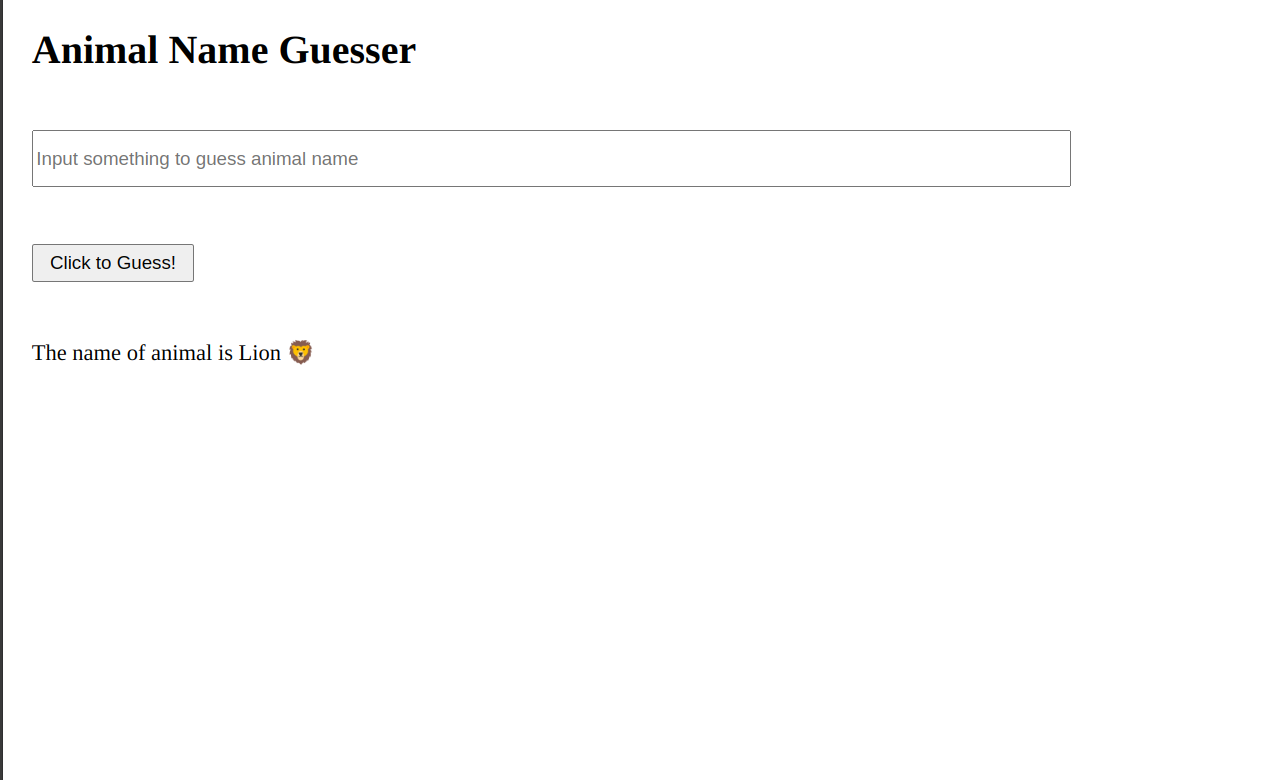
In the second case, we write “How much a Ferrari car cost?“
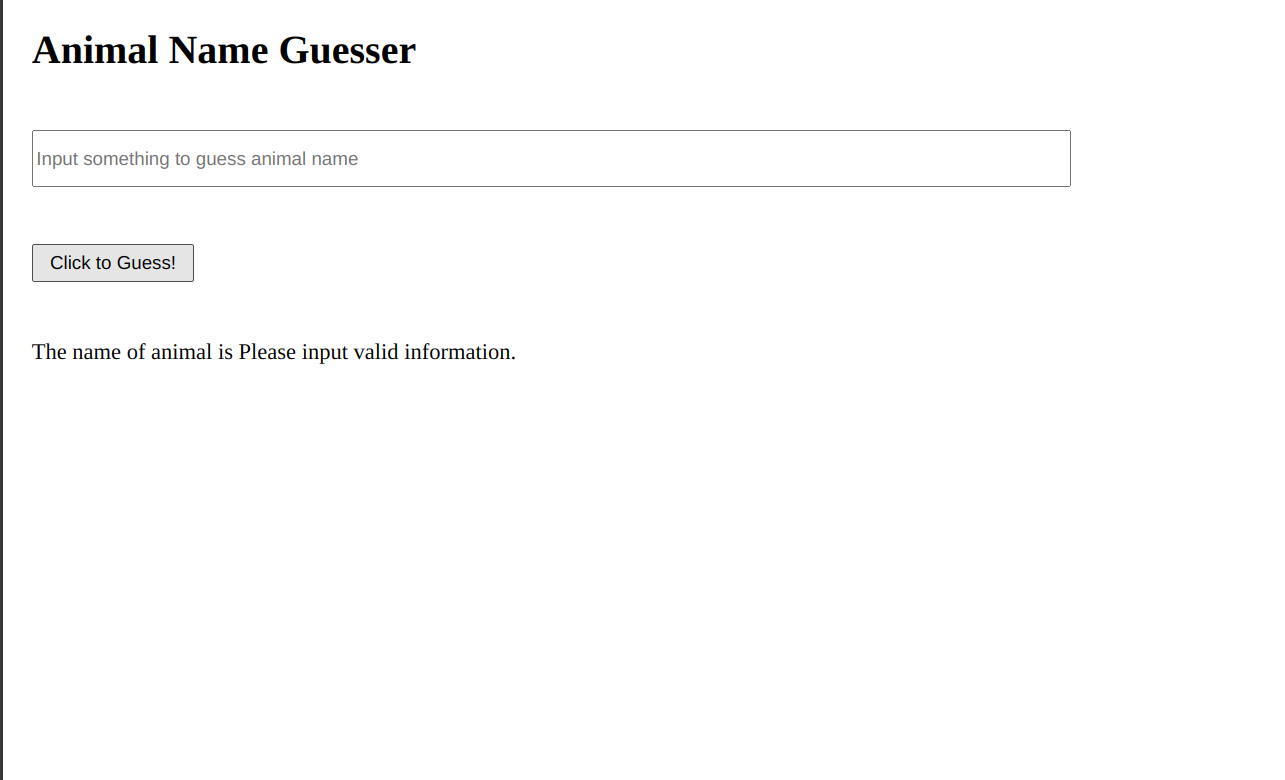
Success! 🎉 The application works perfectly in both cases. This confirms that the Gemini API integration is functioning as expected, providing accurate responses based on the input prompts.
This demonstrates the effectiveness of the integration process and the powerful capabilities of the Gemini API in delivering precise results. 🚀
Some Real-World Examples:
Customer Support Chatbots:
Example: A company integrates the Gemini API into its customer support system to create an intelligent chatbot. This chatbot can understand and respond to customer queries in natural language, providing instant support and reducing the workload on human agents. 🤖💬
Benefit: Enhances customer satisfaction by providing quick and accurate responses, and allows human agents to focus on more complex issues. 😊📈
Content Creation:
Example: A marketing agency uses the Gemini API to generate creative content for social media posts, blogs, and advertisements. The API can produce human-like text based on given prompts, saving time and effort for content creators. 📝✨
Benefit: Increases productivity and ensures a consistent flow of high-quality content, helping the agency meet tight deadlines and maintain an active online presence. 📅📈
Educational Tools:
Example: An educational platform integrates the Gemini API to create interactive learning modules. Students can input questions or topics, and the API generates detailed explanations, examples, and even quizzes to enhance learning. 📚🧠
Benefit: Provides personalized learning experiences, making education more engaging and accessible to students of all levels. 🎓🌟
Healthcare Assistants:
Example: A healthcare app uses the Gemini API to offer virtual health consultations. Patients can describe their symptoms, and the API provides preliminary advice or suggests potential diagnoses, which can then be reviewed by a healthcare professional. 🏥💬
Benefit: Improves access to healthcare information and helps in early detection of health issues, potentially saving lives. ❤️🩺
In summary, the Gemini API is a powerful tool that offers versatility, generative capabilities, customization, security, and efficiency. Its real-world applications span various industries, demonstrating its potential to transform how we interact with technology and information. 🌐🚀
Elevate your project with Google Gemini API integration, a versatile multimodal AI supporting text, images, audio, and more. This guide explores the core features, including multimodal support, generative capabilities, and security, and offers step-by-step instructions to integrate Gemini API using Node.js and client-side JavaScript. Additionally, it introduces a fun Animal Name Guesser Game project showcasing Gemini's potential. And talk about some Real-world applications like customer support chatbots, content creation, educational tools, and healthcare assistants demonstrate Gemini API's transformative capabilities. Get ready to harness the power of AI in your projects! 🌟🚀
Happy Coding! 💻😊
Subscribe to my newsletter
Read articles from Nehal Jain directly inside your inbox. Subscribe to the newsletter, and don't miss out.
Written by

Nehal Jain
Nehal Jain
I'm a Sophomore exploring Computer Science 👨💻. Currently working on Backend in JS environment. Write blogs on GenAI 🤖 Dev, JS Dev and also write for developers to fasten their Dev journey. Also I'm ready to contribute in Projects 🤝